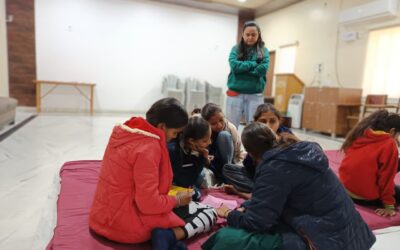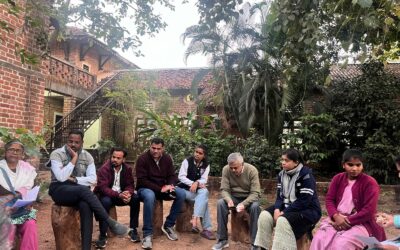“What do you want to do in life?”
Miles away from the progressive urban city center, are families living on its peripheries, grappling with the regular socio-political confusion. Leaving behind their agro-based livelihoods as a way to move forward in their lives, they are shocked to realize that they have been left far behind in the race of ‘development’. Their first battle is internal—facing the weight of broken aspirations —followed by the harsh reality of surviving in an unforgiving city.
Trapped between two diametrically opposing lifestyles, their journey is riddled with contradictions. Grinding away at low-income low-security informal jobs, some try to change the cycle generationally but often fail to do so. However, the pathway to transformation is usually elusive. Their voices, often not reaching the top, become muffled and soon fade away.
“What do you want to do in life?” I asked a group of young girls with bright, sparkling eyes, sitting rather uncomfortably in a small, boxy room that doubled as an Anganwadi, tucked away in a small peri-urban village of Bihar on a hot afternoon.
The Bright Eyed Young Girls
Some had travelled on foot, others on bicycles, eager to hear what we had to offer. The muted voices could not reach me so I asked again.
”Surely you have thought of something that you want to achieve?”
My words seemed to only deepen their discomfort. Hollow glances passed between them, as though my question had unearthed a reality they hadn’t yet dared to confront. My colleague repeated the question although in another tone, “have you been inspired by someone? Do you wish to be like them?”
The silence persisted. Finally, I asked “would you like to do something?”
To this the response shifted and some sparkly eyes became misty. The tears revealed a turmoil between dreams and hopelessness.

The Matter At Hand
The team had collected the crowd that day to introduce a new opportunity—a government-sponsored ‘Fashion Diploma’ course, now made free for those from minority communities, including religious minorities and scheduled tribes. A year-long course, unlike the usual short-term training under the Pradhan Mantri Kaushal Vikas Yojana (PMKVY), offered comprehensive skills and placement opportunities.
For the girls already adept at stitching and tailoring, this course represented a rare chance to elevate their craft, possibly even to become designers, leading production in industry and finally moving up the income hierarchy. The promising opportunity also promised hope to those who had never imagined realities other than the ones they already knew. Excited at the opportunity, the room buzzed with questions.
They Asked Tree Questions
And with each question, the new budding hope withered; further and further.
Question 1: “Are there any requirements for admission?”
The facilitator answered, “You’ll need an Aadhar card, a minority certificate, and a 10th-grade passing certificate.” For girls who had lived on the fringes of society, an identity and an education—were anything but simple. A silence settled over the room as eyes turned downward.
Question 2: “Will the classes be every day? Where? For how long?”
“Classes will run six days a week at our institute in the heart of the city, six hours a day.” The 20kilometers between their homes and the city might as well have been an ocean that they were asked to cross without a boat. 6 hours for 6 days was a commitment impossible to make with the limited mobility. More eyes dropped to the floor.
Question 3: “Will we find jobs in our hometowns?”
“No, unfortunately, Bihar doesn’t have many textile industries. You’d have to move to another city.” By then, not a single girl’s eyes remained lifted.
Equity And Access To Skill Development
Chapter 3 of the National Skill Development Policy discusses the need for equity and access to skill development. It highlights specific clauses and provisions for the inclusion of populations that are geographically difficult to reach, disadvantaged groups (scheduled castes, scheduled tribes, and other backward classes), minorities, women, persons with disabilities, school drop-outs, and economically challenged populations. The policy offers tailored solutions to address the many barriers that prevent these groups from benefiting from such initiatives.
However, policies failing to align with reality or not effectively translating on the ground, make it impossible for the most needy to access their rights.
Hope is dangled before those who need it most, only to be snatched away. The silence that filled the room that day was not just an absence of words but a reflection of the deep disjunct between opportunity and access. This experience left me pondering about the measures that are needed to be taken to jump from employability to employment. The real question is no longer about what these girls aspire to be. It’s about how we can reform our systems to ensure that when they dare to dream, their ambitions are met with genuine opportunities, not silence.




0 Comments